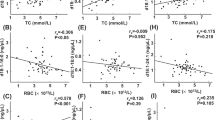Abstract
The present study was designed to assess whether changes in glycolipids and cyclic AMP contents might serve as markers for the diagnosis of malignancy in the liver. The experimental model was a transplantable murine hepatoma. Experimental mice were divided into three groups: (1) a therapeutic group, which had been transplanted with hepatoma and treated with the antimetabolism drug 5-flurouracil (0.2 mg/day i.p.), (2) a control group, which had been transplanted with hepatoma and treated with 0.2 ml 0.9% NaCl/day and (3) a normal group of mice. The ganglioside and cAMP contents in the hepatoma tissue, plasma cAMP, total- and lipid-bound sialic acid levels and red blood cell membrane sialic acid levels were determined. Results showed that the ganglioside content, total and lipid-bound sialic acid levels in the control group were significantly higher than those in the livers of normal mice (p < 0.01) while these respective values in the therapeutic group were significantly lower than those in the control group (p < 0.01). The cAMP levels of tumor tissues and plasma in the control group were lower than those in normal mice. No significant difference in red blood cell membrane sialic acid content was observed between the therapeutic and control groups though levels for both were higher than those in normal mice. These results indicate that ganglioside content and sialic acid levels in hepatoma tissues were significantly elevated, and cAMP levels in hepatoma tissues were significantly decreased during proliferation and abnormal differentiation.
Similar content being viewed by others
References
Hangwei B, Thomas NS: Influence of ganglioside GM3 and high density lipoprotein on the cohesion of mouse brain tumor cells. J Lipid Res 38: 160–172, 1997
Nahar TO, Williams NA, Hirst TR: Cross-linking of cell surface ganglioside GM1 induces the selective apoptosis of mature CD8T lymphocytes. Int Immunol 8: 731–736, 1996
Weis FM, Davis RJ: Regulation of epidermal growth factor receptor signal transduction. Role of gangliosides. J Biol Chem 265: 12059–12066, 1990
Wiegandt H: The chemical constitution of gangliosides of the vertebrate nervous system. Behav Brain Res 66: 85–91, 1994
Nagai Y: Functional role of gangliosides in bio-signaling. Behav Brain Res 66: 99–105, 1995
Wang F, Burkley NE, Spiegel S: Involvement of sphingolipids metabolites in cellular proliferation modulated by ganglioside GM1. Glycoconj J 13: 937–945, 1996
Ortaldo JR, Mason AT, McVicar DW: T cell activation via the disialoganglioside GDS: Analysis of signal transduction. J Leukoc Biol 60: 533–539, 1996
Kiura K: An alteration of ganglioside composition in cisplatinresistant lung cancer cell line. Anticancer Res 18: 2957–2960, 1998
Marguina G: Gangliosides expressed in human breast cancer. Cancer Res 56: 5165–5171, 1996
Kishida E: Characterization of gangliosides from Ehrlich ascites tumour cells and their variants. Glycoconj J 13: 127–134, 1996
Berra B, Colombo I, Sottocornola E: Glycosphingolipid expression in solid tumours and transformed cell line. Indian J Biochem Biophys 34: 170–177, 1997
Stefeneli N: Serum sialic acid in malignant tumors. Bacterial infection and chronic liver disease. J Cancer Res 109: 55–59, 1985
Hakomont S: Aberrant glycosylation in cancer cell membranes as focused on glycolipids: Review and perspectives. Cancer Res 45: 2405–2414, 1985
Nonda K: Lipid-associated sialic acid test for the detection of human cancer. Cancer Res 42: 5270–5275, 1982
Kemal ME, Ames D J, George G K: Use and limitations of serum total and lipid-bound sialic acid concentrations as markers for colorectal cancer. Cancer 15: 404–409, 1985
Alton LS, Charles WP, David MK: Radioimmunoassay for cyclic nucleotides. J Biochem 247: 1106–1113, 1972
Hata K, Wada T, Miyagi T: Purification and characterization of a membrane-associated ganglioside sialidase from bovine brain. J Biochem Tokyo 123: 899–905, 1998
Distrian AM, Schwartz MK, Fracchia AA: Serum lipid-bound sialic acid as a marker in breast cancer. Cancer 50: 1815–1819, 1982
Bai H,Seyfried TN: Influence of ganglioside GM3 and high density lipoprotein on the cohesion of mouse brain tumor cells. J Lipid Res 38: 110–172, 1997
Hirschberg K: Ganglioside synthesis during the development of neuronal polarity. J Biochem 271: 14876–14883, 1996
Shi WX, Chammas R, Varkei A: Linkage-specific action of endogenous sialic acid o-acetyltransferase in Chinese hamster ovary cells. J Biochem 271: 15130–15138, 1996
Idota T, Kawakami H: Inhibitory effects of milk gangliosides on the adhesion of Escherichia coli to human intestinal carcinoma cells. Biosci Biotechnol Biochem 59: 69–72, 1995
Roesler WJ, Vandenbark GR, Hanson RW: Cyclic AMP and the induction of Eukaryotic gene transcription. J Biochem 263: 9063–9066, 1988
Author information
Authors and Affiliations
Rights and permissions
About this article
Cite this article
Lu, C.Q., Lu, J., Wang, B.L. et al. Changes in ganglioside contents, plasma sialic acid and cAMP levels in experimental hepatoma in mice. Mol Cell Biochem 207, 29–33 (2000). https://doi.org/10.1023/A:1007029927664
Issue Date:
DOI: https://doi.org/10.1023/A:1007029927664




